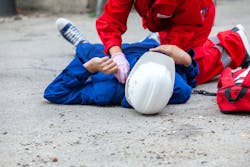I enjoy cooking, and I’d say I’m a decent cook. I know how to follow a recipe, and I’ve learned a trick or two over the years. If you were a dinner guest, I think you’d enjoy your meal. But you might not like it if we were cooking alongside each other in the kitchen.
I’d never serve you a sneeze muffin or something that had fallen on the floor. I’m meticulous about disinfecting surfaces where meat has been prepped. I always wash my hands before and between tasks. But I’m also clumsy pretty much all of the time, and I’m unwieldy with my chef’s knife.
Over the past two years, I have found myself at the center of some unwanted attention from my boyfriend and mom. They both agree, and have bonded over the fact, that I’m an accident waiting to happen in the kitchen.
They’ll usually volunteer to do any chopping, dicing, mincing or julienning. I don’t protest, especially with onions. My eyes burn and water so much that I usually struggle to keep them open. My mom bought me a pair of onion goggles a few Christmases ago that help, but because they form a kind of suction to your face, I must take off my glasses to use them. Even with my nearsightedness, I squint to see what’s in front of me, creating a very unsafe situation.
My boyfriend pretty much summed it up the other night as I was attempting to cover baked penne that was already in the oven with aluminum foil. I was struggling with the wire rack and the oven mitts to cover the 9x13 pan. After I finally managed, my boyfriend simply remarked, “You always find the most dangerous way to do things.” I countered that the oven mitt had a hole in it, but I’m not sure that helped my case.
I have never been bothered by my poor cooking techniques before because I’ve always thought that I had a good feel for the process (and pretty quick reflexes). But hearing some of your stories has made me think twice. I don’t want to lose a fingertip or feeling in my arm because I suck at cutting onions. I’ve had dozens of near misses, and while I’m certainly thankful, I realize I need to change my ways to avoid an all but certain future.
I know the stakes are much higher on the job site, but perhaps my pedestrian example can serve you. Are there things that you know you do (or others have pointed out) that can be considered unsafe? What have you witnessed of others’ behaviors? Have you said anything?
We’ve all heard accounts of tragic accidents that could have, should have or ought to have been avoided. I think it’s safe to say no one wants to get injured, maimed or worse. It’s not as though we leave for work planning to come home injured. If anything, we’re probably thinking about all the things we have to do, or have the joy and privilege of doing, after the workday is done.
People always say accidents happen. Sometimes, they do by a seemingly random string of events. Most times, though, they are a result of unsafe behaviors and habits that we have acquired over time. Seen this way, they have been accidents waiting to happen all along.
That’s why recognizing those poor behaviors and intervening earlier is so critical, both for ourselves and the safety of others. I can say, “Look, Mom, I haven’t drawn blood yet,” but that doesn’t mean I’m a safe cook. After all, I have trimmed my fingernails with my knife blades.
I follow most rules in the kitchen, but I clearly have room for improvement. I resolve to focus on my cooking techniques, so I can learn safer behaviors and avoid future accidents. It’s time for me to roll up my sleeves and get to chopping. Here’s to the safest—and tastiest—French onion soup yet!
About the Author
Nicole Stempak
Nicole Stempak is managing editor of EHS Today and conference content manager of the Safety Leadership Conference.


